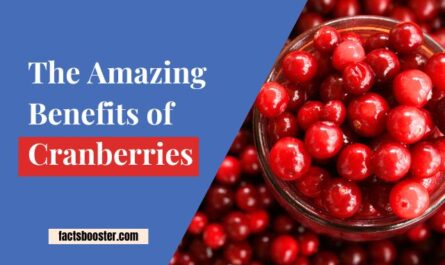A low cholesterol diet is essential for maintaining heart health and reducing the risk of cardiovascular diseases. This comprehensive guide provides you with a 9-meal plan, complete with preparation steps and health benefits, to help you lower your cholesterol levels naturally.
How a Low-Cholesterol Diet Can Help Manage Cholesterol Levels
A low-cholesterol diet focuses on foods that are low in saturated fats and high in fiber. This type of diet can help reduce low-density lipoprotein (LDL) cholesterol, often referred to as “bad” cholesterol, while increasing high-density lipoprotein (HDL) cholesterol, known as “good” cholesterol.
Reducing LDL cholesterol is crucial because high levels can lead to plaque buildup in the arteries, increasing the risk of heart disease. By incorporating cholesterol-lowering foods such as whole grains, fruits, vegetables, lean proteins, and healthy fats, you can effectively manage your cholesterol levels and improve your overall cardiovascular health.
Key Components of a Low-Cholesterol Meal Plan
A low cholesterol meal plan should include the following key components:
- Whole Grains: Foods like oatmeal, brown rice, and quinoa are rich in fiber, which helps reduce cholesterol absorption in the bloodstream.
- Fruits and Vegetables: Packed with vitamins, minerals, and antioxidants, fruits and vegetables help protect the heart and lower cholesterol.
- Lean Proteins: Opt for lean protein sources like chicken, fish, beans, and legumes, which are low in saturated fats.
- Healthy Fats: Include sources of healthy fats, such as avocados, nuts, and olive oil, to help increase HDL cholesterol levels.
- Low-Fat Dairy: Choose low-fat or non-fat dairy products to reduce saturated fat intake.
Read more:
9 Low Cholesterol Meal Plan
1. Oatmeal with Berries and Nuts
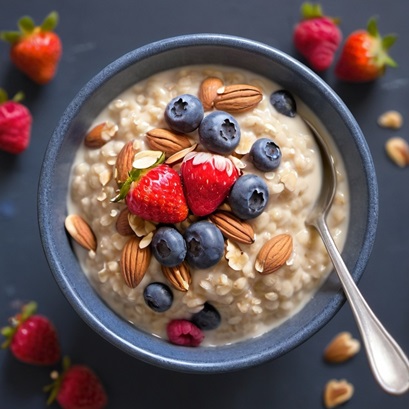
Steps to Prepare:
- Cook 1/2 cup of rolled oats in water or low-fat milk.
2. Top with a handful of fresh berries (such as blueberries, strawberries, or raspberries).
3. Add a sprinkle of chopped nuts (like almonds or walnuts) for added crunch and healthy fats.
4. Drizzle with a touch of honey or maple syrup for sweetness.
Benefits: Oatmeal is rich in soluble fiber, which helps reduce LDL cholesterol. Berries are high in antioxidants, and nuts provide healthy fats, making this a heart-healthy breakfast option.
2. Grilled Chicken Salad with Avocado and Olive Oil Dressing
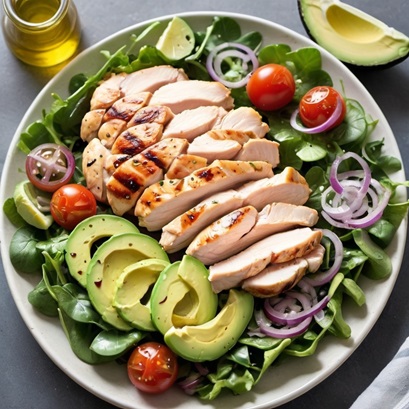
Steps to Prepare:
1. Grill a boneless, skinless chicken breast until cooked through.
2. Slice the chicken and place it over a bed of mixed greens.
3. Add slices of avocado, cherry tomatoes, cucumber, and red onion.
4. Drizzle with homemade olive oil, lemon juice, salt, and pepper dressing.
Benefits: This salad is high in lean protein and healthy fats. Avocado provides monounsaturated fats that help increase HDL cholesterol, while olive oil is a great source of heart-healthy fats.
3. Quinoa and Vegetable Stir-Fry
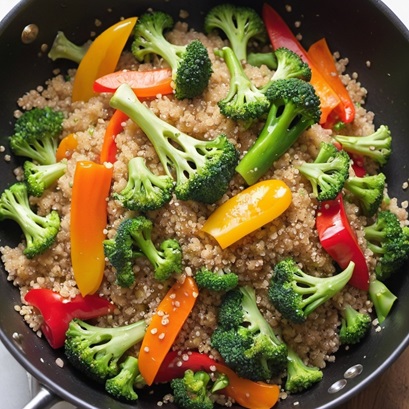
Steps to Prepare:
1. Cook 1 cup of quinoa according to package instructions.
2. In a pan, sauté a mix of your favorite vegetables (such as bell peppers, broccoli, carrots, and snap peas) in a small amount of olive oil.
3. Add the cooked quinoa to the pan and stir-fry for a few minutes.
4. Season with low-sodium soy sauce or tamari for added flavor.
Benefits: Quinoa is a complete protein and is high in fiber, which helps manage cholesterol levels. Vegetables add vitamins, minerals, and antioxidants to this nutritious dish.
4. Lentil Soup with Spinach and Tomatoes
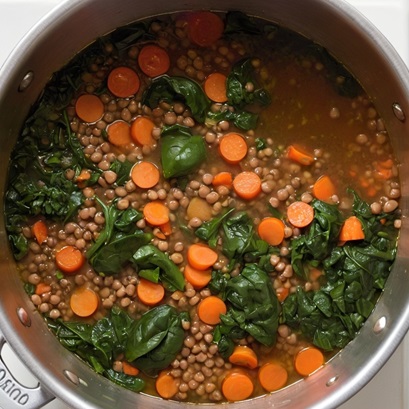
Steps to Prepare:
1. In a pot, sauté diced onions, carrots, and celery in olive oil until softened.
2. Add 1 cup of lentils, 4 cups of low-sodium vegetable broth, and a can of diced tomatoes.
3. Bring to a boil, then reduce heat and simmer until lentils are tender.
4. Stir in fresh spinach leaves and cook until wilted.
Benefits: Lentils are high in fiber and protein, making them an excellent choice for cholesterol management. Spinach and tomatoes provide additional nutrients and antioxidants.
5. Whole Wheat Pasta with Marinara Sauce and Vegetables
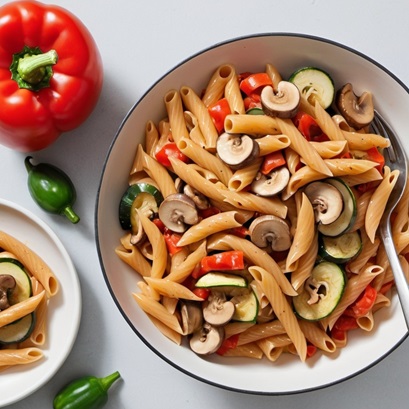
Steps to Prepare:
1. Cook whole wheat pasta according to package instructions.
2. In a separate pan, sauté a mix of vegetables (such as zucchini, mushrooms, and bell peppers) in olive oil.
3. Add a jar of low-sodium marinara sauce to the pan and simmer.
4. Toss the cooked pasta with the sauce and vegetables.
Benefits: Whole wheat pasta is high in fiber, which helps lower cholesterol. The vegetables provide additional vitamins and minerals, while the marinara sauce is low in saturated fats.
6. Baked Salmon with Asparagus and Quinoa

Steps to Prepare:
1. Preheat the oven to 375°F (190°C).
2. Place a salmon fillet on a baking sheet and season with salt, pepper, and a drizzle of olive oil.
3. Bake for 15-20 minutes, or until the salmon is cooked through.
4. Serve with a side of steamed asparagus and cooked quinoa.
Benefits: Salmon is rich in omega-3 fatty acids, which can help reduce triglycerides and increase HDL cholesterol. Asparagus and quinoa provide additional fiber and nutrients.
7. Stuffed Bell Peppers with Brown Rice and Black Beans
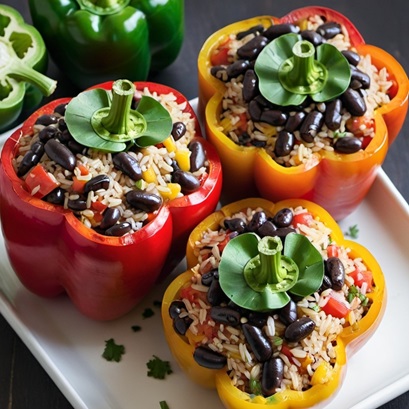
Steps to Prepare:
1. Preheat the oven to 375°F (190°C).
2. Cut the tops off of bell peppers and remove the seeds.
3. In a bowl, mix cooked brown rice, black beans, diced tomatoes, and spices.
4. Stuff the bell peppers with the mixture and bake for 30-35 minutes.
Benefits: This dish is high in fiber and protein, which can help manage cholesterol levels. Brown rice and black beans are low in saturated fats and rich in nutrients.
8. Greek Yogurt Parfait with Nuts and Fruit
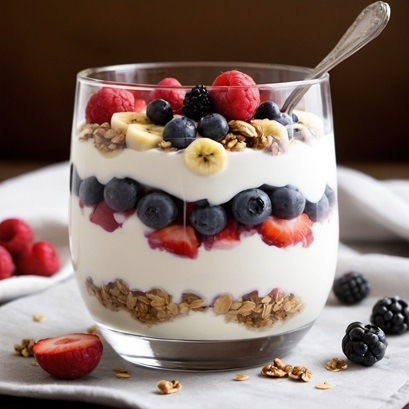
Steps to Prepare:
1. In a glass, layer low-fat Greek yogurt, fresh fruit (such as berries or sliced banana), and a sprinkle of granola or nuts.
2. Repeat the layers as desired and drizzle with a little honey if needed.
Benefits: Greek yogurt is a good source of protein and calcium, and low in fat. The nuts provide healthy fats, and the fruit adds fiber and antioxidants.
9. Chickpea and Vegetable Curry with Brown Rice

Steps to Prepare:
1. In a pot, sauté diced onions, garlic, and ginger in olive oil until fragrant.
2. Add a can of chickpeas, diced tomatoes, and a mix of your favorite vegetables.
3. Stir in curry powder and a cup of low-sodium vegetable broth.
4. Simmer until the vegetables are tender and serve over cooked brown rice.
Benefits: Chickpeas are a great source of fiber and protein, which help manage cholesterol. The curry is rich in spices that provide additional health benefits, while brown rice adds whole grains to your diet.
Tips for Sticking to a Low Cholesterol Diet
- Plan Your Meals: Prepare a weekly meal plan that includes a variety of low-cholesterol meals to keep your diet interesting and balanced.
- Read Food Labels: Be mindful of the cholesterol and saturated fat content in packaged foods. Opt for items labeled as “low cholesterol” or “heart-healthy.”
- Incorporate Fiber: Include plenty of high-fiber foods like oats, fruits, vegetables, beans, and whole grains in your diet.
- Limit Saturated Fats: Avoid high-fat meats, full-fat dairy products, and processed foods that are high in saturated fats.
- Stay Active: Regular physical activity helps boost HDL cholesterol and lower LDL cholesterol levels.
Conclusion
A low cholesterol meal plan is an effective way to manage your cholesterol levels and improve your heart health. By incorporating a variety of nutrient-dense meals and following the tips provided, you can enjoy delicious foods while taking care of your cardiovascular health. Start your journey to a healthier heart today with these 9 low cholesterol meal options, and see the benefits of a heart-healthy diet for yourself!


